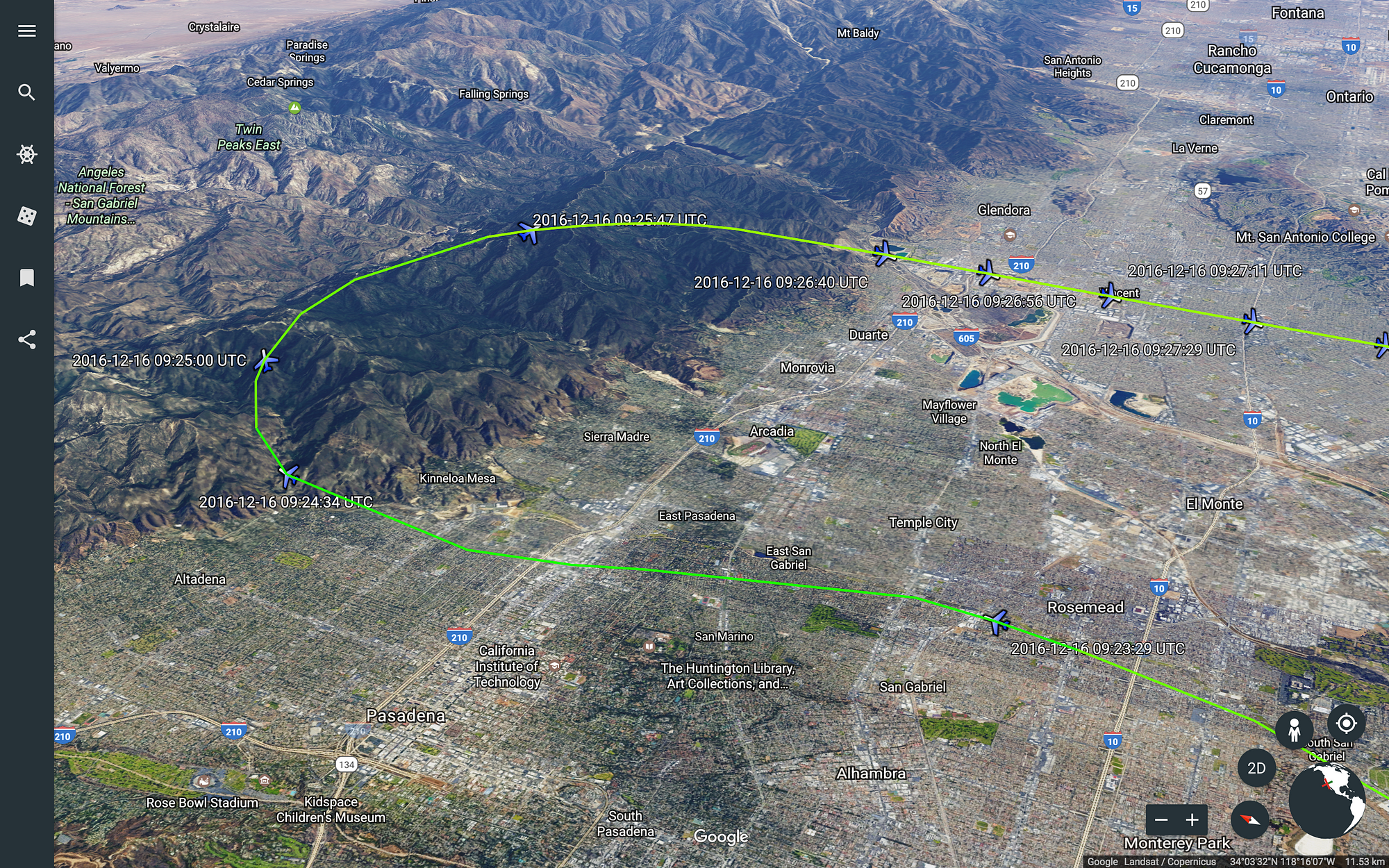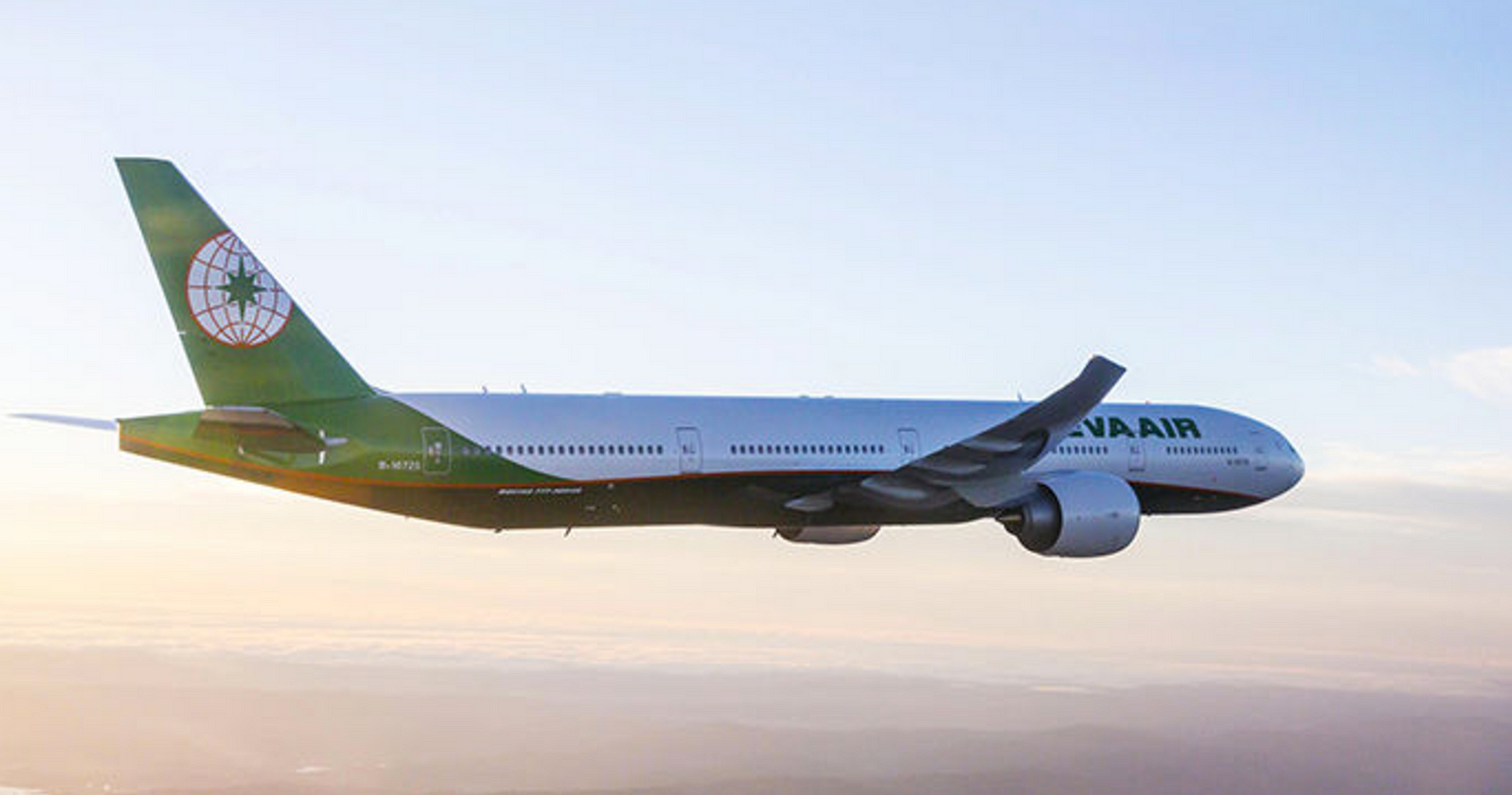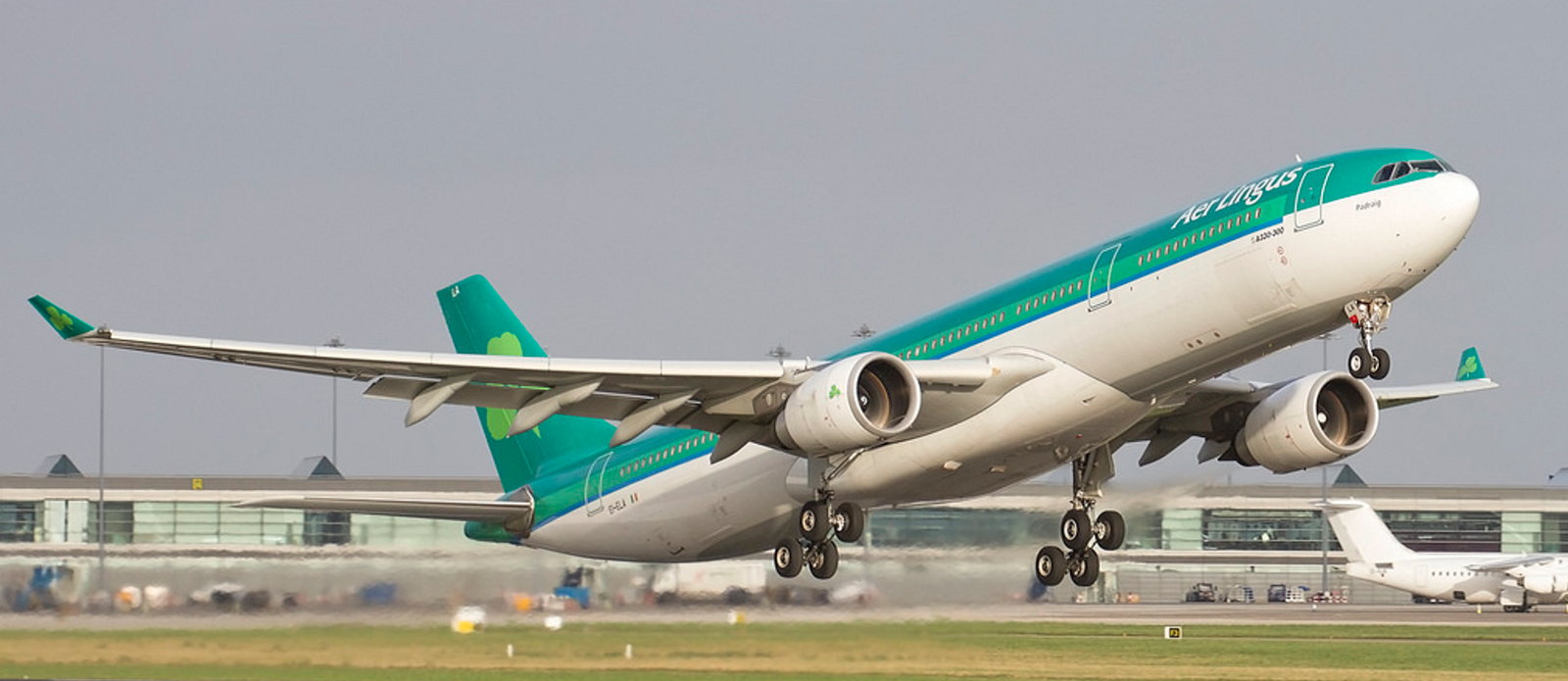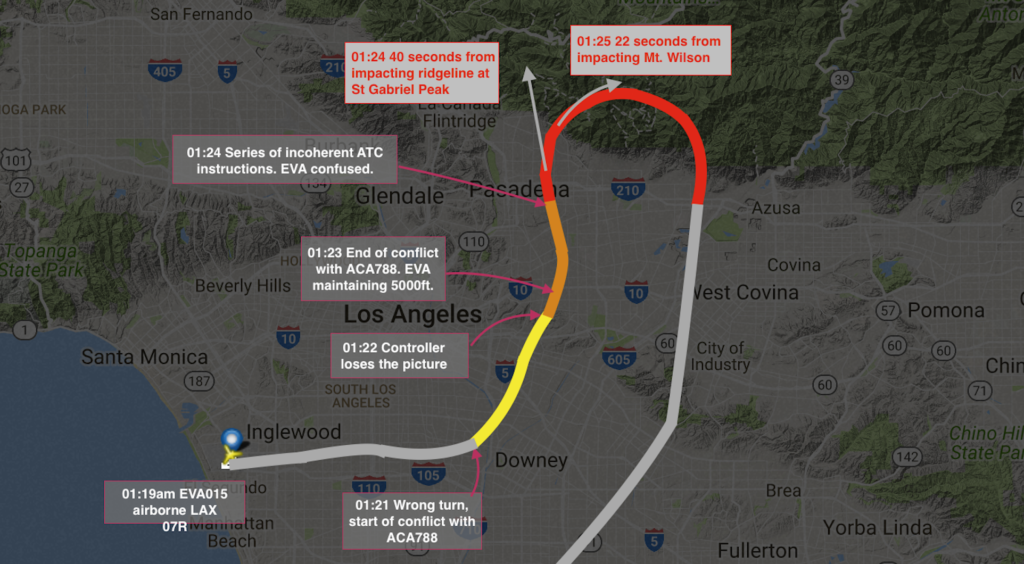In any one of the plausible alternative endings to this event, a departing Boeing 777 impacts the San Gabriel mountains at about 5000 feet, just east of Los Angeles, at 1.25am.
Exactly how this didn’t happen is almost unexplainable. With 353 people on board, this was 22 seconds away from being the worst air disaster in the US.
For a solid 3 minutes in the early morning, the Boeing was being guided not by the pilots, not by the Air Traffic Controller, but by the precipitous balance between good fortune and tragic fate.
At 1.24 am, level at 5,000 feet, the flight is 40 seconds from impacting a ridge-line west of St Gabriel Peak. A minute later, a wide turn to the right points the aircraft instead at Mt Wilson — now 22 seconds away and above the aircraft. Only a slow climb, the result of fumbled instructions and a gradual realisation by the crew of the danger, released the flight from a certain and conclusive end in the dark hills.
So exactly what happened? On December 16th last year, at 1.19am, EVA 015, a Boeing 777–300ER with 353 occupants, got airborne from Runway 7R at Los Angeles. 2 minutes after departure, the aircraft starts to make a turn in a direction opposite to that expected by the controller. That left turn immediately sets up a conflict and potential loss of separation with Air Canada 788.
With that conflict resolved, more by the natural tendency of airplanes to diverge than by any positive control instruction, the overall scene becomes bleaker. Rattled by the unanticipated loss of separation, the controllers’ picture is lost; fumbled left-right-left instructions confuse the Boeing crew, and very soon, nobody is actually flying the airplane.

______
The ATC recording and track replay is YouTube nirvana for the congregation of armchair experts (the writer included). “Terrible controlling” is the common cry. “The pilots were at fault” say the counter-parties.
There is no doubt that this is Air Traffic Control at its darkest. But in any incident where we smugly allocate blame to one individual, we are blind to a bigger story. There is always a systemic failure to look at. In this case, there are several.

Loss of Separation vs. Real collision risk
—
For an Air Traffic Controller, there is a subconscious difference between the fear of losing separation (the legal minimum distance), and the fear of an aircraft collision. The purpose of ATC is to prevent collisions, but the mindset of an Air Traffic Controller is focused on preventing loss of separation. This is an important distinction.
A loss of separation is a traumatic experience for any ATCO. It results in immediate suspension of the right to work, remedial training, a loss of confidence, and a few sleepless nights. Even if the required separation is 5 miles, and a controller allows aircraft to pass with 4.9, it’s game over.
And so, in any conflict on the radar scope that looks like it might become a loss of separation, the controller (being a human being) will encounter physiological symptoms — shock being the first, activating the autonomic nervous system — increasing heart and breathing rate, and releasing adrenaline. These are helpful for both of the Fight or Flight options, but not for thinking clearly. The psychological impact of the loss of separation blurs the importance of preventing a collision.
Training wins
—
I’ve worked as both pilot and controller. Faced with pressure, we revert to the level of our training. This is why pilots visit the flight simulator every couple of months. We’ve trained to the point that an engine exploding as we rotate the aircraft off the runway is no longer a shock that renders us useless. If this were to happen in reality, we still feel the adrenaline and shock — but we can plunge straight into the “Engine Failure subroutine”. We have training to revert to. Listen to Aer Lingus Flight 120 experiencing this. You can hear the training, and you can also hear the adrenaline. Training wins.
For Air Traffic Controllers, faced with an unexpected situation, we also revert to training —but we don’t train for our emergencies in the same way that pilots do. The training, in fact, isn’t there to revert to.
As a controller, I’ve held Tower, Approach, and Enroute ratings in different countries. ATC training in how to separate airplanes is excellent. Training in how to recover from the unexpected is not.
Ultimately, it’s the same deal. Both Pilots and Controllers spend 99.99% of their time operating in the routine. It’s not uncommon for a pilot to spend his entire career without encountering an engine shutdown. Similarly, many controllers retire without ever having lost separation.
But it would be unthinkable for an airline to have crews that don’t know what to do in an emergency. Why then, is it acceptable to not offer controllers the same degree of contingency training?
Emergencies and ATC
—
When we talk about ATC Emergency training, what we are really used to looking at is what to say and do when a pilot has an emergency. Mayday, Pan-Pan, Emergency descent, Hijack.
But what about when ATC has their own emergency. When you’ve missed a conflict, have a deep loss of separation, lost the picture — when you’ve completely screwed up. Somewhere in the manual, there’s probably a few lines about using standard phraseology, exercise best judgement, provide traffic information, don’t interfere with an RA.
As humans, this doesn’t help us. There is no patter to fall into. We need trigger phrases to kick off trained behaviour when the shock of the event wants to take us elsewhere. In the cockpit that I flew in, whatever happened, the trigger phrase was “Take action”. From here, whatever the situation, we knew where to go. Identify the problem, run the checklist, push buttons, talk to ATC.

In the Aer Lingus example above: Mayday, Shamrock 12G, Engine Failure, Climbing straight ahead, Standby.
Alert — Identification — Situation — Intentions — Request.
Clear as a bell.
On the EVA tape, it is clear that the controller has no such place to go to. It’s the equivalent of trying to exit an underwater shipwreck with no guide rope. You need something to hold onto as you find your way back to the surface.
She never did. After the shock of the loss of separation, she was now faced with a 777 heading into the 6500ft San Gabriel hills level at 5000 feet. She did not move on from preventing a loss of separation to preventing a collision with terrain. Even when apparently finally realising the aircraft was heading for high ground, there was little in the way of an urgent climb or turn instruction, and nothing that mentioned to the crew that they were in immediate danger.

Losing the picture
_
If we consider ourselves to blame for the situation, it will cloud our judgement, obscuring the true picture. If we allow that to develop further, we can lose the picture entirely. There is nothing in our training that gives us a clear path out of the loss of separation. No mnemonics, no patter, no phraseology.
This is the lesson to be learned from this event. ATC agencies should make available to their controllers the same degree of emergency and “unusual situation” training that airlines offer to pilots. And somewhere in there has to be an ingrained, trained-by-rote-reminder that when you lose separation, you immediately pick up the fallen cards and move on to preventing a collision, whether that is with another aircraft or terrain.
In the EVA 015 incident, we can be thankful that the sheer mercy of fate allowed all on board to thread their way through and out the other side of the San Gabriel mountains. If ATC training were more cognisant of the human factors aspect of the shock of losing separation, we may not have to rely on the mercy of fate next time.
More on the topic:
- More: More face scans at the US border: BizAv now included
- More: Mexico Customs Surprises: Pills, Vapes, and Laptop Rules
- More: Greenland NAT Alternates: Dec 2025 Update
- More: Crossing the Quiet South: From Australia to Argentina
- More: Major runway shutdowns ahead at KVNY/Van Nuys
More reading:
- Latest: More face scans at the US border: BizAv now included
- Latest: Mexico Customs Surprises: Pills, Vapes, and Laptop Rules
- Latest: Greenland NAT Alternates: Dec 2025 Update
- Safe Airspace: Risk Database
- Weekly Ops Bulletin: Subscribe
- Membership plans: Why join OPSGROUP?












 Get the famous weekly
Get the famous weekly 






Radar, radar, radar. Always have the radar on and properly tilted. Would have saved the Cali flight as well.
I’ve always wondered if the GPWS was chirping or showing yellow and red. Or if there were radar altitude alerts in the cockpit. It doesn’t take much to get turned around, lose situational awareness and then become task saturated. A USAF C130 turned the wrong way out of Denver during a Clinton presidential trip and hit the Rockies. And this wasn’t a foreign crew in a foreign land. I’m glad as hell this didn’t make the front pages but the incident should be treated as an accident anyway. Like attempted murder is treated as such. ( I’m not comparing this to a crime, but it was mostly luck that there wasn’t a crash). Pilots and controllers must use this as a major learning experience, as if the aircraft hit the mountains. It would be a shame to not visit this in simulation during recurrent training.